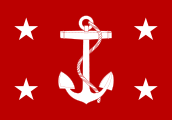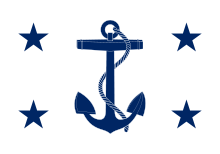Benjamin F. Tracy
| Benjamin Franklin Tracy | |
|---|---|
 | |
| 32nd United States Secretary of the Navy | |
|
In office March 6, 1889 – March 4, 1893 | |
| Preceded by | William C. Whitney |
| Succeeded by | Hilary A. Herbert |
| Personal details | |
| Born |
April 26, 1830 Apalachin, New York, U.S. |
| Died |
August 6, 1915 (aged 85) Tioga County, New York, U.S. |
| Political party | Republican |
| Profession | Politician |
| Awards | Medal of Honor |
| Military service | |
| Allegiance |
United States of America Union |
| Service/branch | Union Army |
| Rank |
Colonel Brevet Brigadier General |
| Commands | 109th New York Infantry Regiment |
| Battles/wars |
American Civil War *Battle of the Wilderness |


Benjamin Franklin Tracy (April 26, 1830 – August 6, 1915) was a United States political figure who served as Secretary of the Navy from 1889 through 1893, during the administration of U.S. President Benjamin Harrison.[1][2]
Biography
He was born in the hamlet of Apalachin located in the Town of Owego, New York on April 26, 1830.[1]
Tracy was a lawyer active in Republican Party politics during the 1850s. He was a member of the New York State Assembly (Tioga Co.) in 1862. During the Civil War, he commanded the 109th New York Infantry Regiment. He was awarded a Medal of Honor for his actions during the Battle of the Wilderness on May 6, 1864. According to the official citation, Tracy "seized the colors and led the regiment when other regiments had retired and then reformed his line and held it."[3] Later that year, he became commandant of the Elmira prisoner of war camp, before being appointed Colonel of the 127th Infantry, U.S. Colored Troops, on August 23, 1864.[4] Tracy was discharged from the volunteer service on June 13, 1865.[5] On January 18, 1867, President Andrew Johnson nominated Tracy for appointment to the brevet grade of brigadier general of volunteers, to rank from March 13, 1865, and the U.S. Senate confirmed the appointment on February 21, 1867.[6]
He resumed the practice of law after the war, and became active in New York state politics. He was United States Attorney for the Eastern District of New York from 1866 to 1877. In December 1881, he was appointed by Governor Alonzo B. Cornell to the New York Court of Appeals to fill the vacancy caused by the appointment of Judge Charles Andrews as Chief Judge after the resignation of Charles J. Folger. Tracy remained on the bench until the end of 1882 when Andrews resumed his seat after being defeated by William C. Ruger in the election for Chief Judge.
Tracy was noted for his role in the creation of the "New Navy", a major reform of the service, which had fallen into obsolescence after the Civil War. Like President Harrison, he supported a naval strategy focused more on offense, rather than on coastal defense and commerce raiding. A major ally in this effort was naval theorist Captain Alfred Thayer Mahan, who had served as a professor at the new Naval War College (founded 1884). In 1890, Mahan published his major work, The Influence of Sea Power upon History, 1660–1783—a book that achieved an international readership. Drawing on historical examples, Mahan supported the construction of a "blue-water Navy" that could do battle on the high seas.
Tracy also supported the construction of modern warships. On June 30, 1890, Congress passed the Navy Bill, a measure which authorized the construction of three battleships. The first three were later named USS Indiana (BB-1), USS Massachusetts (BB-2), and USS Oregon (BB-3). The battleship USS Iowa (BB-4) was authorized two years later.
Tracy's wife and child perished in a fire at their residence in Washington, DC in 1890.
After leaving the Navy Department, Tracy again took up his legal practice. In 1896, he defended New York City Police Commissioner Andrew Parker against Commission President Theodore Roosevelt's accusations of negligence and incompetence, in a performance that significantly embarrassed Roosevelt. (ref. Edmund Morris, The Rise of Theodore Roosevelt, p. 555) He also helped negotiate a settlement to the boundary dispute between Venezuela and Great Britain which had culminated in the Venezuela Crisis of 1895.
Tracy was the Republican candidate to be the first Mayor of Greater New York City when the five boroughs consolidated in 1898. He came in third behind Democrat Robert A. Van Wyck and Seth Low of the Citizens' Union, winning 101,863 of the 523,560 votes cast in the election of 1897.
Tracy died at his farm in Tioga County, New York on August 6, 1915 at 3:30 am at the home of his daughter.[1][2]
Medal of Honor citation

Rank and organization: Colonel, 109th New York Infantry.
Place and date: At Wilderness, Va., 6 May 1864.
Entered service at: Owego, N.Y.
Born: 26 April 1830, Owego, N.Y.
Date of issue: 21 June 1895.
Citation: Seized the colors and led the regiment when other regiments had retired and then reformed his line and held it.[7]
Namesake
USS Tracy (DD-214) was named for him, as was the town of Tracyton, Washington.[8]
Tracy Arm is a fjord in the U.S. state of Alaska that bears his name.
See also
- List of American Civil War Medal of Honor recipients: T–Z
- List of American Civil War generals (Union)
Notes
- 1 2 3 "Gen. Benj. F. Tracy Dies In 86th Year. Soldier, Statesman, Jurist Had Been in Coma Since Paralytic Stroke. Father Of Fighting Navy. As Secretary Under Harrison He Took the Department Out of Politics. Funeral Monday.". New York Times. August 6, 1915. Retrieved 2010-10-04.
General Benjamin Franklin Tracy, Secretary of the Navy under President Harrison, died at 3:30 yesterday afternoon at the home of his daughter, ...
- 1 2 "Gen. Benjamin F. Tracy Dead". Wall Street Journal. August 6, 1915. Retrieved 2010-10-04.
General Tracy was born in Owego, NY, April 28, 1830. He was admitted to the Bar in 18... and was elected a of the New York Assembly in 18.2. ...
- ↑ Army citation "Medal of Honor recipients" Check
|url= - ↑ 127th U.S. Colored Troops Infantry: Roster, http://www.ranger95.com/civil_war_us/us_color_troops/infantry/127th_us_color_troop_inf.htm.
- ↑ Eicher, John H., and David J. Eicher, Civil War High Commands. Stanford: Stanford University Press, 2001. ISBN 0-8047-3641-3. p. 535
- ↑ Eicher, 2001, p. 759
- ↑ Army citation "Medal of Honor recipients" Check
|url= - ↑ Majors, Harry M. (1975). Exploring Washington. Van Winkle Publishing Co. p. 82. ISBN 978-0-918664-00-6.
References
- Eicher, John H., and David J. Eicher, Civil War High Commands. Stanford: Stanford University Press, 2001. ISBN 0-8047-3641-3.
 This article incorporates public domain material from websites or documents of the United States Army Center of Military History.
This article incorporates public domain material from websites or documents of the United States Army Center of Military History. This article incorporates public domain material from websites or documents of the Naval History & Heritage Command.
This article incorporates public domain material from websites or documents of the Naval History & Heritage Command. Chisholm, Hugh, ed. (1911). "Tracy, Benjamin Franklin". Encyclopædia Britannica 27 (11th ed.). Cambridge University Press.
Chisholm, Hugh, ed. (1911). "Tracy, Benjamin Franklin". Encyclopædia Britannica 27 (11th ed.). Cambridge University Press.
Further reading
- Cooling, Benjamin F. Benjamin Franklin Tracy, Father of the American Fighting Navy. Hamden, Conn.: Archon Books, 1973.
External links
| Wikimedia Commons has media related to Benjamin F. Tracy. |
| Wikisource has original text related to this article: |
- Michael J. Crawford; Mark L. Hayes; Michael D. Sessions (November 30, 1998). "The Spanish-American War: Historical Overview and Select Bibliography". Naval Historical Center. Retrieved September 29, 2010.
- Michael A. Palmer (September 22, 2004). "The Navy: The Oceanic Period, 1890-1945". Naval Historical Center. Retrieved September 29, 2010. (Copyright notice from Naval Historical Center website: "Used by permission of Charles Scribner's Sons, an imprint of Simon & Schuster Macmillan from Encyclopedia of the American Military, John E. Jessup, Editor in Chief. Vol. I, pp. 365-380. Copyright c 1994, Charles Scribner's Sons, 1633 Broadway, New York, NY 10019. [The views expressed in this history are those of the author and do not reflect the official policy or position of the Department of the Navy or the U.S. government.]")
- "Photograph of Tracy as Secretary of the Navy, c. 1890 From the Library of Congress". Retrieved September 29, 2010.
- "Secretary of the Navy: Benjamin F. Tracy (1889-1893) Brief biography from AmericanPresident.org". Retrieved September 29, 2010.
- The Influence of Sea Power Upon History, 1660-1783 by A. T. Mahan at Project Gutenberg Project Gutenberg link to Mahan's The Influence of Sea Power Upon History, 1660–1783
- "The Political Graveyard". Retrieved September 29, 2010.
| Legal offices | ||
|---|---|---|
| Preceded by Benjamin D. Silliman |
U.S. Attorney for the Eastern District of New York 1866–1877 |
Succeeded by Asa W. Tenney |
| Government offices | ||
| Preceded by William C. Whitney |
United States Secretary of the Navy 1889–1893 |
Succeeded by Hilary A. Herbert |
| |||||||||||||||||||||||||||||||||||
| ||||||||
|


